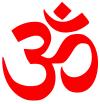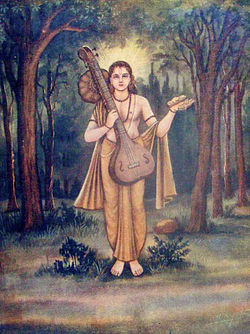Naradiya Purana
| Part of a series on |
| Hindu scriptures and texts |
|---|
 |
| Related Hindu texts |
| Part of a series on |
| Vaishnavism |
|---|
 |
|
|
The Naradiya Purana (Sanskrit: नारदीय पुराण, Naradiya Purana) or Narada Purana (Sanskrit: नारद पुराण), are two Sanskrit texts, one of which is a Major Purana of Hinduism, while the other is a Minor Purana (Upapurana).[1] Both are Vaishnavism texts, and have been a cause of confusion in Puran-related scholarship.[2] To prevent confusion, some scholars sometimes refer to the Minor Puran as Brihannaradiya Purana.[1][2]
Unlike most Puranas that are encyclopedic, the Brihannaradiya text is focussed almost entirely on Vishnu worship, while the Naradiya text is a compilation of 41 chapters (20%) on Vishnu Worship and rest of the chapters (80%) cover a wide range of topics including a large compilation of Mahatmya (travel guides)[3] to temples and places along river Ganges, and neighboring regions.[2][4]
The Naradiya Purana is notable for dedicating eighteen chapters on other Puranas, one entire chapter summarizing each major Purana.[5] It is also notable for its verses extolling Buddha in chapter 1.2.[6]
[7] History[edit]

Manuscripts of nearly all the Major Puranas acknowledge the existence of a Major Puran named either Narad or Naradiya, suggesting it was an important text in Hindu history.[9] Yet, unlike other Puranas which either appear in the Major Puran or Minor Puran lists, the Narad text appears in both lists.[9] This caused significant confusion to 19th and early 20th century Indologists.[9] The confusion was compounded by the fact that the content of the text manuscripts they found seemed to follow similar scope and focus, except that the Brihannaradiya Purana text with about 3,500 verses was slightly bigger than the other with about 3,000 verses.[9][10]
Later discovered manuscripts and scholarship established that the Narad or Naradiya is the Major Puran, Brihannaradiya is the Upapurana.[11] The Naradiya Purana consists of two bhagas (parts), with the first called Purvabhaga and second called Uttarabhaga.[9] The Purvabhaga has four padas with the total of 125 chapters.[1] The Uttarabhaga has 82 chapters, which embeds the Rukmangada-carita.[9][7]
The Brihannaradiya Purana has no parts or padas, and a total of 38 adhyayas (chapters).[9]
The Narad Puran texts, like other Puranas, exist in numerous versions, but with less variation than other Puranas.[2][12] Wilson states that both texts are of likely recent composition, probably 16th or 17th century, because the five manuscripts he reviewed had verses mentioning certain events after Islamic invasion and control of the Indian subcontinent.[5][10] The other unusual part of the manuscripts he examined, states Wilson, is that the descriptions of ritual worship of Vishnu in the text are "puerile inventions, wholly foreign to the more ancient" ideas in the Puran genre of Hindu texts.[10]
Rajendra Hazra, in contrast, states that the core verses of the texts were likely first composed over various centuries, as follows: he dates the Vishnu Bhakti focussed text Brihannaradiya Purana to the 9th-century; he places the first 41 chapters of Purvabhaga and the first 37 chapters of Uttarabhaga to have been composed before the 11th century; and, the rest he states is of likely a comparatively later origin.[5][1][13] The Naradiya Purana, states Hazra, was likely composed after the Brihannaradiya Purana.[14] It is unknown, adds Hazra, whether the extant manuscripts of the Narad Puranas are same as the 9th and 10th-century originals,[15] but we know that the verses quoted in medieval Hindu Smriti texts with these texts cited as source, are missing from the currently surviving manuscripts.[16]
Rocher states that the composition date of each Puran remains unclear.[17][18] Dimmitt and van Buitenen state that it is difficult to ascertain when, where, why and by whom the major and inor Puranas were written:[19]
As They Exist Today, The Puranas Are A Stratified Literature. Each Titled Work Consists Of Material That Has Grown By Numerous Accretions In Successive Historical Eras. Thus, No Puran Has A Single Date Of Composition. (...) It Is As If They Were Libraries To Which New Volumes Have Been Continuously Added, Not Necessarily At The End Of The Shelf, But Randomly.
— Cornelia Dimmitt and J.A.B. van Buitenen, Classical Hindu Mythology: A Reader in the Sanskrit Puranas[19]
The Padma Puran categorizes Naradiya Purana as a Sattva Puran (which represents goodness and purity).[20] Scholars consider the Sattva-Rajas-Tamas classification as "entirely fanciful" and there is nothing in this text that actually justifies this classification.[21]
Contents[edit]
Brihannaradiya Purana[edit]
The Brihannaradiya Purana (also Brihannarada Purana) is focussed on the Bhakti Of Vishnu.[5] It describes the festivals and ritual ceremonies of Vaishnavism.[5] Many chapters of the text are part of Mahatmya glorifying the river Ganges, pilgrimage and travel centers such as Prayag (meeting point of Yamuna and Ganges rivers) and Banaras (the holy city Of Hindus).[5] The text also includes chapters on ethics and duties of Varna and Ashramas, vrata and summaries on Sanskara (rite of passage).[5]
Narad Puran[edit]
The Narad Puran (also Naradiya Purana) follows the style of the Brihannaradiya Purana in the first 41 chapters of Purvabhaga, but the rest of the first part and second part are encyclopedic covering a diverse range of topics.[5] The encyclopedic sections discuss subjects such as the six Vedangas, Moksha, Dharma, Adhyatma-jnana (monastic life), Pashupata philosophy, a secular guide with methods of worship of Ganesh, various incarnations of Vishnu (MahaVishnu, Narsimha, Hayagriva, Ram, Krishna), Lakshman, Hanuman, goddesses such as Devi and MahaLakshmi, as well as Shiva.[5] The text glorifies Radha as the one whose soul and love manifests all Hindu goddesses.[1]
The text's secular description and verse of praises are not limited to different traditions of Hinduism, but also other traditions. For example, chapter 1.2 extols Buddha.[6] This contrasts with Kurma Puran which is disdainful of Buddhism without mentioning Buddha,[22] but similar to the praise of Buddha in other major Puranas such as chapter 49 of the Agni Puran, chapter 2.5.16 of the Shiva Puran, chapter 54 of the Matsya Puran and various minor Puranas.[23]
Chapters 92 through 109 of Purvabhaga are notable for summarizing the 18 major Puranas, one entire chapter dedicated to each.[5] This has been an important benchmark in comparison studies, and as evidence that the Puranas were revised after the composition of Narad Puran, since the summary in these 18 chapters is significantly different than the extant manuscripts of the major Puranas.[24][25] Other topics covered in the verses of Uttarabhaga include flora and fauna, food, music, dance, dress, jewelry, weapons and theories on war.[26]
The Narad Puran also contains Rukmangadacarita, a legend of king named Rukmangada, whose belief in Vishnu is repeatedly tested by a temptress Mohini (a female incarnation of Vishnu), one that became subject of plays and dance arts in Indian culture.[5][1] After Rukmangadacarita, the text predominantly is a compilation of geographic Mahatmyas or travel guides for pilgrimage along river Ganges starting with Haridwar,[4] through Banaras (Kashi) towards Bengal, and nearby regions such as Gaya in Bihar and Nepal.[5][1]
See also[edit]
References[edit]
- ↑ 1.0 1.1 1.2 1.3 1.4 1.5 1.6 Dalal 2014, p. 272.
- ↑ 2.0 2.1 2.2 2.3 Rocher 1986, pp. 202-203.
- ↑ Ariel Glucklich 2008, p. 146, Quote: The earliest promotional works aimed at tourists from that era were called mahatmyas.
- ↑ 4.0 4.1 James Lochtefeld (2009). Gods Gateway: Identity and Meaning in a Hindu Pilgrimage Place. Oxford University Press. pp. 30–34. ISBN 978-0-19-974158-8.
- ↑ 5.00 5.01 5.02 5.03 5.04 5.05 5.06 5.07 5.08 5.09 5.10 5.11 Rocher 1986, p. 203.
- ↑ 6.0 6.1 Parmeshwaranand 2001, p. 253.
- ↑ 7.0 7.1 Hazra, R.C. (1962). The Puranas in S. Radhakrishnan ed. The Cultural Heritage of India, Vol.II, Calcutta: The Ramakrishna Mission Institute of Culture, ISBN 81-85843-03-1, p.262
- ↑ Dalal 2014, p. 271-272.
- ↑ 9.0 9.1 9.2 9.3 9.4 9.5 9.6 Rocher 1986, p. 202.
- ↑ 10.0 10.1 10.2 Wilson 1864, pp. LI-LIII.
- ↑ Hazra 1940, pp. 127-128.
- ↑ Hazra 1940, pp. 4-13, 127-130.
- ↑ Hazra 1940, pp. 4-13, 127-133.
- ↑ Hazra 1940, p. 127.
- ↑ Hazra 1940, p. 130.
- ↑ Hazra 1940, p. 133.
- ↑ Rocher 1986, p. 203, 249.
- ↑ Gregory Bailey 2003, pp. 139-141, 154-156.
- ↑ 19.0 19.1 Dimmitt & van Buitenen 2012, p. 5.
- ↑ Wilson 1864, p. 12.
- ↑ Rocher 1986, p. 21.
- ↑ Parmeshwaranand 2001, p. 254.
- ↑ Parmeshwaranand 2001, pp. 254-255.
- ↑ Parmeshwaranand 2001, pp. 204, 207, 278, 321.
- ↑ Hazra 1940, pp. 127-133.
- ↑ K P Gietz 1992, p. 323 with note 1778.
Bibliography[edit]
- Gregory Bailey (2003). Arvind Sharma (ed.). The Study of Hinduism. University of South Carolina Press. ISBN 978-1-57003-449-7.
- Dimmitt, Cornelia; van Buitenen, J. A. B. (2012). Classical Hindu Mythology: A Reader in the Sanskrit Puranas. Temple University Press (1st Edition: 1977). ISBN 978-1-4399-0464-0.
- Dalal, Rosen (2014). Hinduism: An Alphabetical Guide. Penguin. ISBN 978-8184752779.
- K P Gietz; et al. (1992). Epic and Puranic Bibliography (Up to 1985) Annoted and with Indexes: Part I: A - R, Part II: S - Z, Indexes. Otto Harrassowitz Verlag. ISBN 978-3-447-03028-1.
- Ariel Glucklich (2008). The Strides of Vishnu : Hindu Culture in Historical Perspective: Hindu Culture in Historical Perspective. Oxford University Press. ISBN 978-0-19-971825-2.
- Parmeshwaranand, Swami (2001). Encyclopaedic Dictionary of Puranas. Sarup & Sons. ISBN 978-81-7625-226-3.
- Hazra, Rajendra Chandra (1940). Studies in the Puranic Records on Hindu Rites and Customs. Motilal Banarsidass (1987 Reprint). ISBN 978-81-208-0422-7.
- Rocher, Ludo (1986). The Puranas. Otto Harrassowitz Verlag. ISBN 978-3447025225.
- Wilson, H. H. (1864). Puranas. ISBN 1-84664-664-2.


